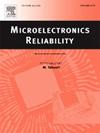Design of an energy-efficient soft error resilient RHBD SRAM cell with high read stability and minimum write errors
IF 1.9
4区 工程技术
Q3 ENGINEERING, ELECTRICAL & ELECTRONIC
引用次数: 0
Abstract
This article proposes an energy-efficient, soft-error tolerant, read-stability improved SRAM cell with less Write Error Rate (WER). The proposed S8P9N has 8 PMOS and 9 NMOS transistors including access transistors. This SRAM cell has only two sensitive nodes, achieved by surrounding the nodes with the same type of transistors. The proposed cell is immune to all Single Event Upsets (SEUs) at sensitive nodes and shows 83.3% and 50% tolerance to Double Node Upsets (DNUs) and Triple Node Upsets (TNUs) respectively. The four access transistors in the S8P9N cell reduce write delay, and WER. Additionally, the proposed SRAM cell achieves the lowest dynamic power dissipation of 1.25 W, high read stability of 320 mW, and low read and write energy of 0.83 aJ and 0.07 fJ, respectively. All designs are implemented using UMC 65 nm technology, operating at a supply voltage of 1.2 V and at a temperature of 27 °. Reliability is analyzed through 5000-point Monte Carlo (MC) simulation under various Process Voltage Temperature (PVT) conditions. The proposed design has a critical charge, Qc of 90 fC . The S8P9N RHBD SRAM cell has a minimum soft error occurrence probability (P) of 1.6%. The combination of low power consumption, low energy, high read stability, less write error rate of 0.1%, and improved reliability makes the S8P9N design suitable for low-power cache in aerospace applications.
具有高读取稳定性和最小写入错误的节能软错误弹性RHBD SRAM单元的设计
本文提出了一种具有低写错误率、节能、软容错、读稳定性的改进SRAM单元。提出的S8P9N具有8个PMOS和9个NMOS晶体管,包括接入晶体管。该SRAM单元只有两个敏感节点,通过在节点周围使用相同类型的晶体管来实现。该细胞对敏感节点上的所有单事件干扰(seu)免疫,对双节点干扰(dnu)和三节点干扰(tnu)的耐受性分别为83.3%和50%。S8P9N单元中的四个存取晶体管减少了写入延迟,降低了WER。此外,该SRAM电池的动态功耗最低为1.25 μW,读取稳定性高达320 mW,读写能量分别为0.83 aJ和0.07 fJ。所有设计均采用联华电子65nm技术,工作电压为1.2 V,温度为27°C。通过5000点蒙特卡罗(MC)仿真分析了不同工艺电压温度(PVT)条件下的可靠性。所提出的设计具有临界电荷,Qc为>;90 c。S8P9N RHBD SRAM单元的最小软错误发生概率(PS)为1.6%。结合低功耗、低能耗、高读取稳定性、少写入错误率<;0.1%,提高可靠性使S8P9N设计适合航空航天应用中的低功耗缓存。
本文章由计算机程序翻译,如有差异,请以英文原文为准。
求助全文
约1分钟内获得全文
求助全文
来源期刊

Microelectronics Reliability
工程技术-工程:电子与电气
CiteScore
3.30
自引率
12.50%
发文量
342
审稿时长
68 days
期刊介绍:
Microelectronics Reliability, is dedicated to disseminating the latest research results and related information on the reliability of microelectronic devices, circuits and systems, from materials, process and manufacturing, to design, testing and operation. The coverage of the journal includes the following topics: measurement, understanding and analysis; evaluation and prediction; modelling and simulation; methodologies and mitigation. Papers which combine reliability with other important areas of microelectronics engineering, such as design, fabrication, integration, testing, and field operation will also be welcome, and practical papers reporting case studies in the field and specific application domains are particularly encouraged.
Most accepted papers will be published as Research Papers, describing significant advances and completed work. Papers reviewing important developing topics of general interest may be accepted for publication as Review Papers. Urgent communications of a more preliminary nature and short reports on completed practical work of current interest may be considered for publication as Research Notes. All contributions are subject to peer review by leading experts in the field.
 求助内容:
求助内容: 应助结果提醒方式:
应助结果提醒方式:


